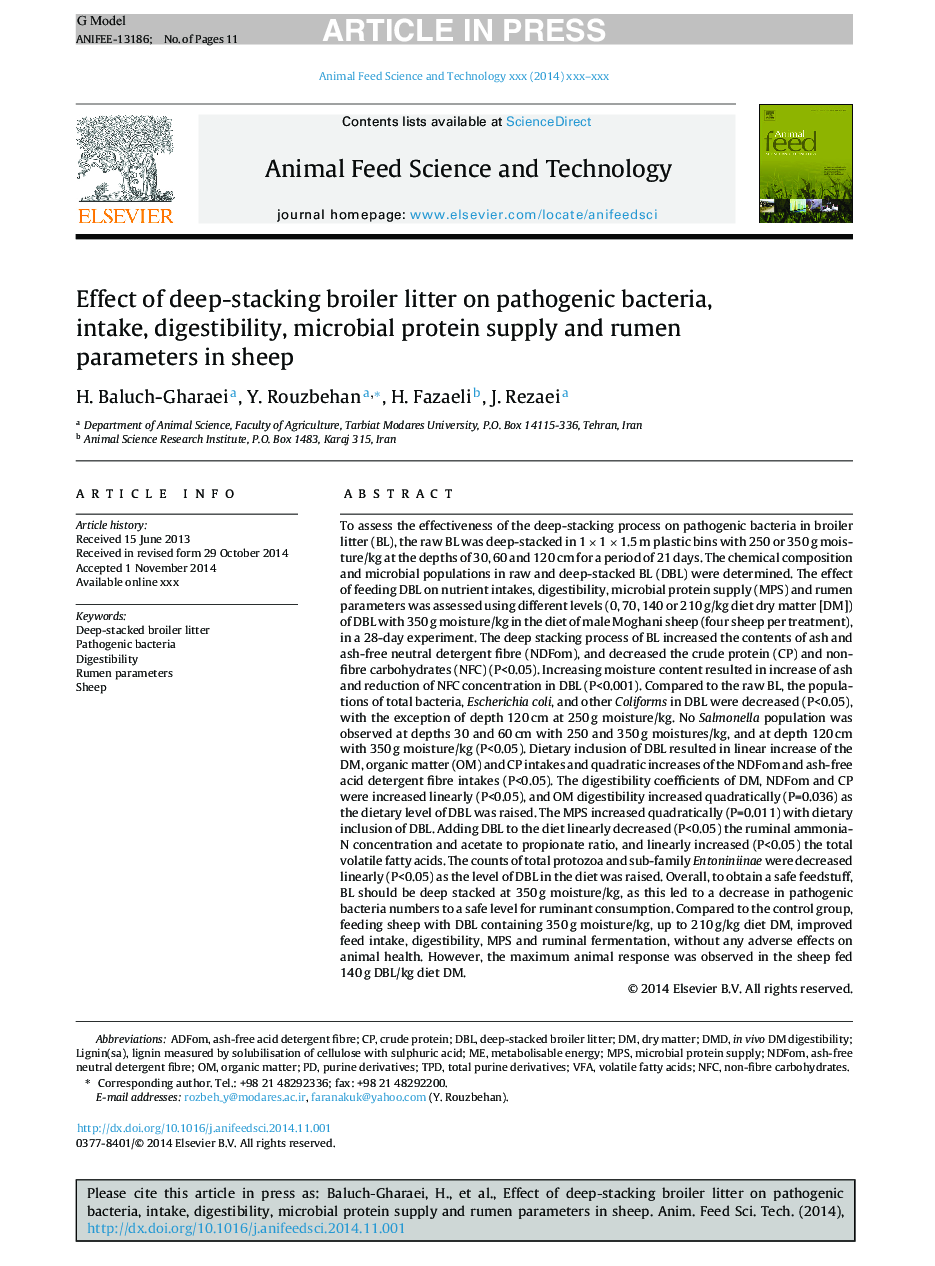| Article ID | Journal | Published Year | Pages | File Type |
|---|---|---|---|---|
| 8491430 | Animal Feed Science and Technology | 2015 | 11 Pages |
Abstract
To assess the effectiveness of the deep-stacking process on pathogenic bacteria in broiler litter (BL), the raw BL was deep-stacked in 1Â ÃÂ 1Â ÃÂ 1.5Â m plastic bins with 250 or 350Â g moisture/kg at the depths of 30, 60 and 120Â cm for a period of 21 days. The chemical composition and microbial populations in raw and deep-stacked BL (DBL) were determined. The effect of feeding DBL on nutrient intakes, digestibility, microbial protein supply (MPS) and rumen parameters was assessed using different levels (0, 70, 140 or 210Â g/kg diet dry matter [DM]) of DBL with 350Â g moisture/kg in the diet of male Moghani sheep (four sheep per treatment), in a 28-day experiment. The deep stacking process of BL increased the contents of ash and ash-free neutral detergent fibre (NDFom), and decreased the crude protein (CP) and non-fibre carbohydrates (NFC) (P<0.05). Increasing moisture content resulted in increase of ash and reduction of NFC concentration in DBL (P<0.001). Compared to the raw BL, the populations of total bacteria, Escherichia coli, and other Coliforms in DBL were decreased (P<0.05), with the exception of depth 120Â cm at 250Â g moisture/kg. No Salmonella population was observed at depths 30 and 60Â cm with 250 and 350Â g moistures/kg, and at depth 120Â cm with 350Â g moisture/kg (P<0.05). Dietary inclusion of DBL resulted in linear increase of the DM, organic matter (OM) and CP intakes and quadratic increases of the NDFom and ash-free acid detergent fibre intakes (P<0.05). The digestibility coefficients of DM, NDFom and CP were increased linearly (P<0.05), and OM digestibility increased quadratically (P=0.036) as the dietary level of DBL was raised. The MPS increased quadratically (P=0.011) with dietary inclusion of DBL. Adding DBL to the diet linearly decreased (P<0.05) the ruminal ammonia-N concentration and acetate to propionate ratio, and linearly increased (P<0.05) the total volatile fatty acids. The counts of total protozoa and sub-family Entoniniinae were decreased linearly (P<0.05) as the level of DBL in the diet was raised. Overall, to obtain a safe feedstuff, BL should be deep stacked at 350Â g moisture/kg, as this led to a decrease in pathogenic bacteria numbers to a safe level for ruminant consumption. Compared to the control group, feeding sheep with DBL containing 350Â g moisture/kg, up to 210Â g/kg diet DM, improved feed intake, digestibility, MPS and ruminal fermentation, without any adverse effects on animal health. However, the maximum animal response was observed in the sheep fed 140Â g DBL/kg diet DM.
Keywords
Related Topics
Life Sciences
Agricultural and Biological Sciences
Animal Science and Zoology
Authors
H. Baluch-Gharaei, Y. Rouzbehan, H. Fazaeli, J. Rezaei,
